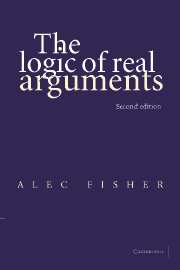Book contents
- Frontmatter
- Contents
- Preface to the first edition
- Preface to the second edition
- Acknowledgements
- 1 Introduction
- 2 A general method of argument analysis
- 3 A first example – from Thomas Malthus
- 4 Reasoning about nuclear deterrence
- 5 An example from John Stuart Mill
- 6 Arguments about God's existence
- 7 How do your mind and body interact?
- 8 Suppose for the sake of argument that …
- 9 An example from Karl Marx
- 10 Evaluating ‘scientific’ arguments. Some initial examples
- 11 Philosophical assumptions
- Appendix: Elementary formal logic
- Exercises
- Bibliography
- List of further reading
- Index
Appendix: Elementary formal logic
Published online by Cambridge University Press: 05 June 2012
- Frontmatter
- Contents
- Preface to the first edition
- Preface to the second edition
- Acknowledgements
- 1 Introduction
- 2 A general method of argument analysis
- 3 A first example – from Thomas Malthus
- 4 Reasoning about nuclear deterrence
- 5 An example from John Stuart Mill
- 6 Arguments about God's existence
- 7 How do your mind and body interact?
- 8 Suppose for the sake of argument that …
- 9 An example from Karl Marx
- 10 Evaluating ‘scientific’ arguments. Some initial examples
- 11 Philosophical assumptions
- Appendix: Elementary formal logic
- Exercises
- Bibliography
- List of further reading
- Index
Summary
‘For a complete logical argument’ Arthur began with admirable solemnity, ‘we need two prim Misses –’
‘Of course!’ she interrupted, ‘I remember that word now. And they produce –?’
‘A Delusion’ said Arthur.
‘Ye-es?’ she said dubiously. ‘I don't seem to remember that so well. But what is the whole argument called?’
‘A Sillygism.’
Lewis Carroll, Sylvie and BrunoIt is likely that anyone who has read this far will be interested in the extent to which formal logic can help in extracting and evaluating arguments. There is no doubt that traditional formal logic contains many ideas and insights which are useful if one is to understand and evaluate arguments. On the other hand it is clearly difficult to apply it to real arguments – to arguments of the kind one finds for example in newspapers, magazines and learned journals.
Elementary classical logic articulates a very clear theory and one which is quite easy to understand. This Appendix is addressed to the reader who knows little or no formal logic but who would like a brief introduction to the subject so that he or she may begin to consider what help logic can give in argument analysis. There are scores of elementary logic texts which develop carefully and clearly the material which we review very briefly here.
What is argument?
Reasoning, or arguing a case, consists in giving reasons for some conclusion: the reasons are put forward in order to establish, support, justify, prove or demonstrate the conclusion.
- Type
- Chapter
- Information
- The Logic of Real Arguments , pp. 172 - 187Publisher: Cambridge University PressPrint publication year: 2004



